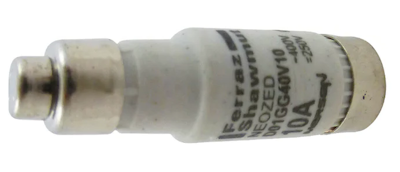How To Choose Industrial Fuses

Figure 1: D01 fuse rated for 10A
Industrial fuses protect circuits and equipment from overcurrent conditions that can lead to damage, fires, or other hazards. It interrupts the current flow when it exceeds a predetermined level, safeguarding the circuit and connected devices. They are robust and designed for higher voltages than residential fuses, typically 400V. Fuse selection for industries involves understanding various parameters such as current and voltage ratings, construction size, and utilization category.
Table of contents
- Construction size
- Rated current
- Rated voltage
- Color codes
- Utilization category
- Example: How to choose a fuse for a circuit
- FAQs
View our online selection of fuses!
Construction size
The construction size of an industrial fuse is determined by the physical dimensions and the current rating it can handle. For example, D01 and D02 are standardized construction sizes for fuses, commonly used in industrial and residential applications (Table 1).
If there is a possibility that the system's current requirements might increase in the future, select a fuse size capable of accommodating higher currents, provided it fits within the physical constraints. Ensure that the chosen fuse is compatible with the fuse holder or base, which must be designed to accommodate the specific dimensions and construction size of the fuse.
Table 1: D01 and D02 construction size features for fuses
| Construction size | Current rating | Dimensions | Applications | Examples |
| D01 | Up to 16A | 36 mm x 11 mm | Suitable for smaller applications where space is limited | Small control circuits, low-power devices |
| D02 | Up to 63A | 36 mm x 15 mm | Designed for larger applications with higher current demands | Larger motors, High power cables and power lines |
Rated current
The rated current, or amperage, is the maximum continuous current a fuse can handle without blowing. To determine the appropriate rated current, use the formula:
Rated current = Actual operating current / 0.75
Choose a fuse with a rated current slightly above the system's operating conditions, but below the capacity of the wires or devices to ensure safe and reliable operation.
Rated voltage
The voltage rating of a fuse is the maximum voltage it can safely interrupt during an overcurrent situation. It's crucial that the fuse's voltage rating is equal to or greater than the circuit's voltage to prevent arcing or sparking when the fuse blows.
For example, in a 24V DC circuit, use a fuse with a voltage rating of 24V or higher, such as 48V, to ensure safety. A fuse with both AC and DC voltage ratings, for example, 400VAC/250VDC, can be used in either AC or DC circuits, provided the voltage in the circuit does not exceed the respective rating.
Color codes
Color codes in industrial fuses quickly identify key specifications such as operational class, rated voltage, and current rating. This system helps prevent errors during fuse replacement, which can lead to malfunctions or overheating. For example, in Siemens 400V fuses, different colors indicate different current ratings: a 6A fuse might be green, while a 25A fuse could be yellow. The color code on a fuse is typically found on the body or cap of the fuse, depending on the design.The color codes vary among manufacturers, so always refer to the specific datasheets for accurate information.
Utilization category
A fuse's utilization category defines its intended application and performance characteristics, particularly its ability to handle specific types of electrical loads and conditions. It also indicates how the fuse will perform under various conditions, such as regular operation, overload, or short-circuit situations.
For example, the gG utilization category refers to general-purpose fuses that provide full-range protection. This means they can interrupt any overcurrent, from small overloads to high short-circuit currents. gG fuses are commonly used for cable and line protection in various electrical systems.
Example: How to choose a fuse for a circuit
Consider protecting a heating element in an industrial setting with the following specifications:
- Operating current: 30A
- System voltage: 230V AC
- Application type: General-purpose protection
Steps to choose the right fuse
- Determine the construction size: Since the operating current is 30A, a D02 construction size is suitable because it can handle up to 63A.
-
Calculate the rated current:
- Rated current = Actual operating current / 0.75.
- For a 30A operating current: Rated current = 30A / 0.75 = 40A.
- Choose a fuse with a rated current slightly above 40A, such as 50A, to ensure it can handle the operating current without blowing.
- Check the voltage rating: Ensure the fuse's voltage rating equals or exceeds the system voltage. For a 230V AC system, select a fuse with a voltage rating of 230V or higher, such as 250V to ensure safety.
- Consider the utilization category: Use a gG utilization category fuse, which is ideal for general-purpose applications like heating elements.
- Verify color codes: Check the color code to ensure it matches the current rating. For example, a 40A Siemens fuse might be color-coded black. Always refer to the manufacturer's documentation for accurate color coding.
- Ensure compatibility: Verify that the selected fuse fits the system's existing fuse holder or base, considering the physical dimensions and the electrical specifications.
FAQs
How to choose a fuse size?
Select a fuse with a rated current slightly above the circuit's operating current and a voltage rating equal to or greater than the circuit voltage, ensuring it fits the requirements.
How to select a fuse holder?
To select a fuse holder, ensure it matches the fuse's construction, supports the circuit's voltage and current ratings, and fits your application's physical space and mounting requirements.







